#Bharti 2020
Text
Ahmednagar Cantt Recruitment 2022 40 Junior Clerk Vacancy
Ahmednagar Cantt Recruitment 2022 40 Junior Clerk Vacancy
#jobtamizhan #govtjobs #governmentrecruitment #centralgovtjobs #tnpsc #upsc #ssc
Ahmednagar Cantt – Office of the Cantonment Board, Ahmednagar Cantt. Recruitment 2022 Apply 40 Junior Clerk Vacancies » Official Notification Released. Central Government Official Release The Notification Interested & Eligible Candidate Please Must Check Full Notification Details, Education Details, Salary Details, Age Relaxation, Vacancies Details, Address Details Next Strat The Apply Process…

View On WordPress
#ahmednagar cantonment board recruitment#ahmednagar cantonment board recruitment 2022#army cantonment board recruitment 2022#cantonment board aurangabad recruitment 2022#cantonment board bharti 2022#cantonment board jabalpur recruitment 2022#cantonment board jabalpur vacancy 2022#cantonment board recruitment 2020#cantonment board recruitment 2022#cantonment board vacancy 2022#cantt board vacancy 2022#cb aurangabad recruitment 2022
0 notes
Text
Astro Observations
misc. (i)




⛔️ TW: mention of anorexia and drugging❗️

♡ Venus Square Mars may attract obsessive people. In particular, people who obsess over their looks or fetishize them in some way. Brooke Shields had a whole nation obsessed with her at the mere age of 12. Eugenia Cooney has infamously attracted hoards of anorexia fetishists with her content. People with this placement may have a higher risk of drastic weight loss or gain.
♡ Either I meet too many Capricorn Suns by coincidence or it's a rather common placement. One reasoning could be that April is an ideal month for marriage in many places, especially ones where it gets unbearably hot in June. Spring adds to April's allure. Traditional couples often conceive right after tying the knot, making the pregnancy due in Capricorn season.
♡ Lilith is associated with sexuality but people focus too much ONLY on that facet of it. Lilith is associated with many other things like power, revenge and how one becomes a social pariah.
♡ Planets at 0° may symbolize struggle. Lana Del Rey has Sun at 0°. The Sun represents our ego. She had many controversies in 2020 including the mesh mask and her Instagram rant undermining POC artists. Even after criticism, instead of apologizing, she remained defensive. I believe that planets at 0° provide a lot of room for growth if the individual is genuinely interested in self-improvement.
♡ Aries Moon (ruled by Mars) and Scorpio Moon (ruled by Pluto, traditionally by Mars) despite being similar are perceived quite differently by people. The sign of Aries gives child-like quality to the native. They come off as cute and their sarcastic remarks are perceived as good humor. E.g. Rihanna roasting Helena Bonham Carter's sense of fashion. Meanwhile, one eyeroll from a Scorpio Moon, and they may come off as hateful and jealous. My advice to Scorpio Moons who want to be in the public eye, please never put on the mean girl persona. Tap into your kind side, it'll be received in a positive way and you'll attract genuine support.
♡ Venus-Mars aspects symbolize beauty; the difference may lie in how people perceive it. Venus Trine Mars are often called cute. People with this aspect are well-liked and have a good reputation. These are the people who may never be cancelled due to the halo effect they have. No matter how massively popular they are, people won't be digging up dirt on them, which is also why very little is known about these people's personal lives. These people often become a household name due to that one iconic thing they did, even if they decide to adapt a lowkey presence afterwards. Let me emphasize this with an extensive list of examples:
✧ Nina Dobrev (The Vampire Diaries), Zayn, Leighton Meester (Gossip Girl), Adele, Kit Harington (Game of Thrones), Sabrina Carpenter, Tobey Maguire (Spider-Man), Kate Middleton, Mandy Moore (A Walk to Remember), Jackie Chan, Jenna Fischer (The Office), Ana de Armas, Josh Hutcherson (The Hunger Games), Constance Wu (Crazy Rich Asians), Rowan Atkinson (Mr. Bean) and Alan Rickman (Harry Potter) have this aspect.
✧ Taeyang being the only member of former K-pop group BIGBANG who's had no controversies (also managed to keep his relationship hidden for a long time before revealing it with a wedding announcement), Khloé Kardashian being the least disliked Kardashian/Jenner sister, Cardi B admitting to drugging and robbing men, starring in Hustlers that glamorized it, hitting her career peak with WAP the very next year really drives the point home.
✧ I've also noticed this aspect in almost all Bollywood IT girls of their time: Priyanka Chopra, Aishwarya Rai, Anushka Sharma, Ayesha Takia, Dia Mirza, Divya Bharti, Parveen Babi - all loved by the general public despite the media scrutiny and misogyny that prevails within the industry.

youtube

Click daily to help Palestinians🍉🙏🏽: https://arab.org/click-to-help/palestine/

#astrology#astro observations#astro notes#astro community#astrology placements#astro posts#astrology notes#astrology observations#astrology community#astrology tumblr#natal astrology#natal placements#natal chart#celebrity astrology#kpop astrology
614 notes
·
View notes
Text
The Dark Side of Honor Killings: Cases that Shocked India

Honor killings remain one of the most disturbing forms of violence in India, highlighting the clash between age-old traditions and modern legal and moral standards. Rooted in rigid concepts of family honor, caste, and patriarchy, these heinous acts often target young couples who defy social norms, such as inter-caste or inter-religious relationships. What makes honor killings even more tragic is the involvement of the victims' own families, driven by the belief that they are restoring honor through violence.In most cases, the victim is a woman, although in several cases the man/boy is also targeted. The victims in some cases are also those belonging to the queer (LGBTQ+) community.
Several cases of honour killings from India’s urban and rural pockets go unreported. The National Crimes Record Bureau’s report for 2020 revealed that 25 cases of “honour killing” were reported in the preceding year. In the previous years, the reports stated that only one incident each took place in 2018 and 2017. But Evidence, an NGO, revealed in November 2019 that as many as 195 known cases of honour killings were reported from Tamil Nadu alone in the past five years.
India has witnessed several brutal cases that shook the nation’s conscience, raising awareness of the deep-seated cultural norms that perpetuate this violence.
https://journals.sagepub.com/
5 Recent Brutal Murders: A Closer Look
1. Nitish Katara Murder Case (2002)
Another chilling case is that of Nitish Katara, a young businessman who was brutally murdered by Vikas Yadav, the son of a prominent politician, because he was in love with Vikas’ sister, Bharti Yadav. The Yadav family, a powerful political dynasty, opposed the relationship as they felt Nitish did not belong to their caste or social class. Nitish was abducted, beaten, and burnt to death in a gruesome crime that shocked the country.The long legal battle for justice was a testimony to how honor killings are often connected to the powerful political class, where perpetrators use their influence to evade justice. The Katara family fought relentlessly, and in 2016, Vikas Yadav was sentenced to life imprisonment, marking a major victory against entrenched social inequalities and caste hierarchies.
https://www.ndtv.com/
2.Manoj-Babli Case (2007)
The infamous Manoj-Babli case from Haryana became a turning point in India's fight against honor killings. Manoj and Babli, who belonged to the same "gotra" (clan), defied societal norms by eloping and marrying. Their marriage enraged Babli’s family and village elders, who deemed their union incestuous, even though it was legal by Indian law. The Khap Panchayat, a local caste council, ordered their murder, and the couple was abducted, tortured, and killed by Babli's relatives.This case was significant as it led to the conviction of several members of the Panchayat, as well as Babli’s family, making it the first time an Indian court had handed down such a severe punishment for an honor killing. The case exposed the authority of Khaps in rural India, which often override state laws, and underscored the urgent need for legal reform to protect young couples.
https://blog.ipleaders.in/
3. Ilavarasan-Divya Case (2013)
The tragic love story of Ilavarasan and Divya from Tamil Nadu exposed how caste continues to dictate relationships and, in extreme cases, lead to honor-based violence. Ilavarasan, a Dalit man, married Divya, a woman from a higher Vanniyar caste, defying the rigid caste system in rural Tamil Nadu. Divya's family and her community could not tolerate their marriage, and her father was accused of driving her to leave Ilavarasan after intense pressure.Soon after, Ilavarasan was found dead near railway tracks, in what many believe to be a planned murder disguised as a suicide. The case caused widespread protests across Tamil Nadu, exposing the caste-based discrimination that still plagues rural India. Ilavarasan’s death was a grim reminder of how deep-rooted prejudices continue to determine the fate of young couples in love, often ending in tragedy.
https://www.thehindu.com/
4. Afsana Case (2020)
Afsana’s case was yet another painful example of how interfaith relationships can become lethal in India. Afsana, a young Muslim woman from Uttar Pradesh, fell in love with a Hindu man, which led to escalating tensions within her conservative family. Afsana’s family disapproved of the relationship, fearing that it would bring shame to their community.In a brutal turn of events, Afsana was strangled to death by her own father and brothers to preserve the family's so-called honor.Afsana’s murder was one among several interfaith love stories in India that faced a similar fate, amplifying the communal tensions surrounding interreligious marriages. Her death not only reflected the patriarchal control over women’s bodies and choices but also pointed to the growing religious intolerance in the country.
https://www.thehindu.com/
5. The Keelvenmani Murders (2021)
In another heart-wrenching case from Tamil Nadu, a Dalit boy, Nirmal Kumar, and his lover, Subhashree, from the dominant Vanniyar caste, were brutally murdered by Subhashree’s family for eloping. The couple, aged just 21 and 20, had sought refuge from Subhashree's relatives who opposed their relationship due to the caste divide. Despite fleeing for safety, they were tracked down and killed in cold blood.This modern-day horror reignited debates about casteism in India, as Subhashree's family faced no remorse for taking the lives of their own kin and her partner. The media coverage and outrage that followed demonstrated how honor killings transcend mere family dynamics and are deeply rooted in India's hierarchical social structure.
https://www.rediff.com/
Laws to Deal with ‘HONOUR KILLING’
In India, honor killings are not governed by a specific law but are prosecuted under general criminal laws, particularly those dealing with murder, homicide, and violence. However, there have been legal measures, court rulings, and proposed bills to address the unique nature of such crimes. Below is an overview of the legal framework and key court interventions in dealing with honor killings:
1. Indian Penal Code (IPC)
Honor killings are generally prosecuted under the following sections of the IPC, which deal with murder and other violent crimes:
Section 302 (Murder): Punishes the crime of murder with life imprisonment or the death penalty.
Section 307 (Attempt to Murder): Applies to cases where the victim survives the attack.
Section 120B (Criminal Conspiracy): Used when multiple people are involved in planning and executing the killing, such as family members or community leaders.
Section 34 (Acts Done by Several Persons in Furtherance of Common Intention): Often used when several people collectively carry out the crime.
Section 364 (Kidnapping or Abduction in Order to Murder): Applied when the victim is kidnapped before being murdered.
Section 376 (Rape): In some cases, sexual assault is also part of the violence related to honor crimes.
2. The Protection of Women from Domestic Violence Act, 2005
While not specifically designed for honor killings, this act provides civil remedies for women facing violence or abuse, including threats of harm related to "family honor." In cases where women are threatened with honor-based violence by their families, they can seek protection under this law.
3. The Indian Constitution
Article 21 (Right to Life): The Supreme Court of India has held that honor killings violate the fundamental right to life and personal liberty enshrined in Article 21 of the Constitution.
Article 14 (Right to Equality): Honor killings, often motivated by caste or gender-based discrimination, are seen as violations of this article, which guarantees equality before the law.
Article 15 (Prohibition of Discrimination on Grounds of Religion, Race, Caste, etc.): In cases where caste or religious differences motivate honor killings, Article 15 is cited.
4. Key Court Judgments
The Supreme Court of India has played a crucial role in addressing honor killings through its judgments, recognizing them as a serious violation of fundamental rights.
Shakti Vahini vs. Union of India (2018): In this landmark judgment, the Supreme Court strongly condemned honor killings and directed state governments to take preventive, remedial, and punitive measures. The court issued guidelines aimed at curbing the influence of Khap Panchayats (traditional caste councils) that often sanction such killings.
Arumugam Servai vs. State of Tamil Nadu (2011): The Supreme Court declared that any person or organization supporting or encouraging honor killings would be subjected to harsh penalties, including the death penalty in certain cases.
5. Proposed Legislation: Prevention of Crimes in the Name of 'Honor' and Tradition Bill, 2010
This proposed bill, introduced in the Rajya Sabha in 2010, sought to address honor killings specifically. Although the bill has not yet become law, it aimed to:
Criminalize the intimidation or harassment of couples who marry against societal or familial norms.
Penalize acts of violence, harassment, or coercion by family members or caste councils (Khap Panchayats).
Impose stricter penalties, including imprisonment and fines, for those found guilty of such crimes.
Criminalize the act of forcing a person into marriage to restore "family honor."
The bill has not been passed, and honor killings continue to be prosecuted under existing criminal laws.
6. Law Commission of India (2012) Recommendations
The Law Commission of India, in its 242nd Report, recommended a specific legal framework to deal with honor crimes. The report called for:
The introduction of a new Section 300A in the IPC to criminalize honor-based crimes.
Recognizing crimes committed in the name of honor as a distinct offense, with special provisions for harsher punishment.
Creating a legal mechanism to tackle the involvement of village or caste panchayats in sanctioning honor killings.
7. Preventive Measures
Police Protection: Courts can direct the police to provide protection to couples who fear for their lives due to the threat of honor killings.
District Magistrate’s Role: The Supreme Court has directed district magistrates to take preventive measures, such as keeping a watch on areas where such crimes are prevalent, and ensuring that couples who marry out of choice are protected.
8. Death Penalty for Honor Killings
While Indian law does not provide a specific provision for the death penalty in honor killing cases, courts have imposed the death sentence in some cases under the "rarest of the rare" doctrine. This doctrine allows for the death penalty in cases where the crime is deemed exceptionally brutal or heinous, as in many honor killing cases.
Honor Killings: The Larger Picture
The common thread in these cases is the deep-seated social structure in India that prioritizes family honor, caste purity, and community approval over individual freedoms and personal choices. Honor killings often occur in rural areas but are not limited to them. The influence of caste-based councils, or Khaps, is still strong in many parts of the country, where they wield unofficial but significant authority, often leading to such heinous crimes.
The Legal Struggle
Despite the growing awareness around honor killings, India does not have a specific law addressing this form of violence. Such killings are prosecuted under general murder laws, but activists argue that these laws fail to address the cultural and social factors that fuel such crimes. Several attempts have been made to pass a comprehensive law targeting honor-based violence, but progress has been slow.
Conclusion
Honor killings reflect the darkest aspects of India’s social fabric, where archaic traditions collide with modern values of personal freedom and choice. The cases of Manoj-Babli, Nitish Katara, Ilavarasan-Divya, and others serve as tragic reminders of the lives lost to this outdated concept of family and social honor. As India continues to evolve, the need for legal reforms, societal education, and support systems for young couples becomes ever more critical to prevent such atrocities in the future. Although India does not have a dedicated law for honor killings, the existing legal framework provides several avenues to prosecute and punish offenders. The judiciary has been proactive in addressing the issue through landmark judgments, while civil society continues to push for specific legislation that acknowledges the unique social and cultural dimensions of honor crimes. Until a comprehensive legal framework is enacted, honor killings will continue to be prosecuted under general criminal laws, and the battle against these brutal practices will rely heavily on enforcement, awareness, and education.
Sources:
www.newindianexpress.com
newindianexpress.com
www.britannica.com
2 notes
·
View notes
Text
The Evolution of Madhubani Art Over Time

Madhubani art (also Mithila art) is a style of painting practiced in the Mithila region of India and Nepal. It is named after the Madhubani district of Bihar, India, which is where it originated. Artists create these paintings using a variety of mediums, including their own fingers, or twigs, brushes, nib-pens, and matchstick. The paint is created using natural dyes and pigments. The paintings are characterized by their eye-catching geometrical patterns. There is ritual content for particular occasions, such as birth or marriage, and festivals, such as Holi, Surya Shasti, Kali Puja, Upanayana, and Durga Puja.
Madhubani painting (or Mithila painting) was traditionally created by the women of various communities in the Mithila region of the Indian subcontinent. It originated from Madhubani district of the Mithila region of Bihar. Madhubani is also a major export center of these paintings.
This painting as a form of wall art was practiced widely throughout the region; the more recent development of painting on paper and canvas mainly originated among the villages around Madhubani, and it is these latter developments that led to the term “Madhubani art” being used alongside “Mithila Painting.”
Mithila paintings mostly depict people and their association with nature and scenes and deities from the ancient epics. Natural objects like the sun, the moon, and religious plants like tulsi are also widely painted, along with scenes from the royal court and social events like weddings. In this paintings generally, no space is left empty; the gaps are filled by paintings of flowers, animals, birds, and even geometric designs.[citation needed] Traditionally, painting was one of the skills that was passed down from generation to generation in the families of the Mithila Region, mainly by women .
It is still practiced and kept alive in institutions spread across the Mithila region. Asha Jha of Madhubanipaints in Darbhanga,
Vaidehi in Madhubani, Benipatti in Madhubani district and Gram Vikas Parishad in Ranti are some of the major centres of Madhubani painting which have kept this ancient art form alive.
Contributions:
The Madhubani painting tradition played a key role in the conservation efforts in India in 2012, where there was frequent deforestation in the state of Bihar. Shashthi Nath Jha, who runs the Gram Vikas Parishad, an NGO, started the initiative as an attempt to protect local trees that were being cut down in the name of expanding roads and development. The main reason behind this was that the trees were traditionally adorned with forms of gods and other religious and spiritual images such as those of Radha-Krishna, Rama-Sita, scenes from Ramayana and Mahabharata and other mythologies.
Darbhanga MP Gopal Jee Thakur started the tradition of honouring people with Mithila Painting in Indian Politics.
Awards:
Madhubani painting received official recognition in 1969 when Sita Devi received the State award by Government of Bihar. Mamta Devi from the village Jitwarpur has also got National Award. Jagdamba Devi from Bhajparaul, Madhubani was given Padma Shri in 1975 and the National Award to Sita Devi of Jitwarpur village near Madhubani.
Jagdamba Devi’s foster son Satya Narayan Lal Karn and his wife Moti Karn are also well-regarded Mithila artists, and they won the National Award jointly in 2003. Sita Devi received the Padma Shri in 1981. Sita Devi was also awarded by Bihar Ratna in 1984 and Shilp Guru in 2006.
In 1984 Ganga Devi was awarded by Padma Shri. Mahasundari Devi received the Padma Shri in 2011. Baua Devi, Yamuna Devi, Shanti Devi, Chano Devi, Bindeshwari Devi, Chandrakala Devi, Shashi kala Devi, Leela Devi, Godavari Dutta, Asha Jha and Bharti Dayal were also given the National award.
Chandrabhushan (Rasidpur), Ambika Devi (Rasidpur), Manisha Jha were also given the National award.[citation needed] In 2020, Madhubani artist Dulari Devi won the Padma Shri for contributions to art.
Styles:
Mithila art has five distinctive styles:
Bharni
Katchni
Tantrik
Godna
Kohbar
In the 1960s Bharni, and Tantrik styles were mainly done by Brahman women in India and Nepal. Their themes were mainly religious and they depicted Gods and Goddesses paintings. People of other castes included aspects of their daily life and symbols, the story of Raja Shailesh (guard of the village) and much more, in their paintings. Nowadays Madhubani art has become a globalised art form, so there is no difference in the work on the basis of the caste system. They work in all five styles. Mithila art has received worldwide attention.
The paintings were traditionally done on freshly plastered mud walls and floors of huts, but now they are also done on cloth, handmade paper and canvas.
Madhubani paintings are made from the paste of powdered rice. Madhubani painting has remained confined to a compact geographical area and the skills have been passed on through centuries, the content and the style have largely remained the same. Thus, Madhubani painting has received GI (Geographical Indication) status. Madhubani paintings use two-dimensional imagery, and the colors used are derived from plants. Ochre, Lampblack and Red are used for reddish-brown and black, respectively.
For more info visit our Website — https://madhubniart.com/
Best Madhubani art near me, Cheapest Madhubani art, Cheapest Madhubani art near me, Madhubani art gallery, madhubani art history, Madhubani art information, madhubani art about, madhubani art book, madhubani art types, Madhubani Art Pen Holder, Madhubani Art Beautiful Jar, Madhubani Art Bowl, Madhubani Art Ceramic Mugs
8 notes
·
View notes
Text
Holistic Development at BBPS, Brij Vihar

At Bal Bharati Public School (BBPS), our approach to education goes beyond conventional academic teaching, aiming to foster holistic development in every student. Recognized as one of the best CBSE schools in Ghaziabad and consistently ranked among the Top 10 CBSE schools in Ghaziabad, we are dedicated in creating an environment where students thrive in all aspects of their growth.
A Comprehensive Educational Philosophy
Our commitment to holistic education is a core principle at Bal Bharati Public School, known for being one of the best private schools in India. This philosophy encompasses not only academic excellence but also emotional, social and ethical development. By aligning our practices with the National Education Policy (NEP) 2020, we emphasize Foundational Literacy and Numeracy and integrate essential 21st-century skills into our teaching methodologies.
Fostering Academic Excellence and Innovation
As a reputed CBSE school in India, Bal Bharati Public School maintains high standards in academics. We offer a rigorous curriculum designed to develop critical thinking and problem-solving skills. Our classrooms are equipped with modern technology that enhances the learning experience, thus, supporting our standing as one of the best public schools in India. The innovative use of technology ensures that students are well-prepared for the future.
Promoting Emotional and Social Growth
At BBPS, we understand that academic success is only part of a student’s education. Emotional and social development is equally important. We cultivate a supportive environment where students learn resilience, empathy and effective communication. This holistic approach helps students grow into well-rounded individuals capable of navigating various life challenges.
Extra-curricular Opportunities and Facilities
Our school provides a wide range of extra-curricular activities and outstanding facilities at Bal Bharati Public School. From sports and arts to diverse clubs and societies, students have ample opportunities to explore their interests and talents. These activities are designed to complement the academic curriculum, reinforcing our reputation as one of the best-rated public schools. Our facilities support this broad array of activities, contributing to the overall development of our students.
Global Awareness and Responsibility
Incorporating global themes such as Sustainable Development Goals (SDGs) and G20 into our curriculum is a key part of our holistic approach. We aim to prepare students to be informed global citizens who understand and address significant global issues. This global perspective helps students develop a sense of responsibility and awareness, preparing them to contribute positively to the world.
Continuous Assessment and Support
Our assessment methods are designed to be continuous and comprehensive, in line with NEP 2020 guidelines. This approach allows us to monitor each student’s progress and provide targeted support where needed. By focusing on the ongoing evaluation, we ensure that every student receives the guidance necessary to excel academically and personally, reinforcing our status as a leading reputed CBSE school in India.
BBPS Group of Schools: A Tradition of Excellence
As part of the BBPS group of schools, Bal Bharati Public School upholds a legacy of educational excellence. Our dedication to holistic development and quality education enhances our reputation as one among the Top 10 CBSE schools in Ghaziabad and solidifies our position as one of the best private schools in India.
Bal Bharti Public school fee structure is easy to access and is reasonable enough without compromising on quality. This balance ensures that we remain a preferred choice for families seeking top-notch education.
At Bal Bharati Public School (BBPS), we are committed towards nurturing students who excel academically while also developing them emotionally and socially. Our holistic development approach, supported by excellent facilities and an innovative curriculum, prepares students to become capable and compassionate leaders in an ever-changing world.
#best cbse school in ghaziabad#good schools in ghaziabad#best schools in ghaziabad cbse board#top schools in ghaziabad
0 notes
Text
Starlin rakibi OneWeb bu yıl Kazakistan'da hizmet verecek

Sabit ve alçak yörüngeli iletişim uydusu operatörü olan İngiliz şirketi OneWeb, 2024 yılında Kazakistan'da uydu İnternet hizmetleri vermeye başlayacak. İlgili mesaj Kazakistan Dijital Kalkınma, Yenilik ve Havacılık ve Uzay Sanayii Bakanlığı'nın web sitesinde yayınlandı .
Kokterek uzay iletişim merkezi bölgesinde, sabit olmayan iletişim ağı OneWeb için bir arayüz istasyonu oluşturma çalışmaları tamamlanıyor. Açıklamada, ticari hizmetlerin sağlanmasına yönelik teknik hazırlığın 2024 yılı için planlandığı belirtildi.
OneWeb uydu iletişimi, diğer şeylerin yanı sıra, Kazakistan'daki köylerin internete bağlanmasını sağlayacak. Bu yöndeki çalışmalar, Kazak yetkililerin OneWeb ile 2021 yılında imzaladığı iş birliği anlaşması çerçevesinde yürütülüyor. Ayrıca Orta Asya ülkeleri sakinlerine yüksek hızlı İnternet sağlamak için ülkede bir OneWeb teknik merkezinin açılması da planlananıyor. Astana'daki uzay aracı montaj ve test kompleksinde OneWeb uyduları için bileşenlerin bir araya getirilmesi olasılığı değerlendirildi. Bu projenin detayları açıklanmadı.
OneWeb'in 2012 yılında kurulduğunu ve 2019 yılında uzaya ilk uyduyu gönderdiğini hatırlatalım. Çeşitli zamanlarda şirketin yatırımcıları arasında Airbus, Qualcomm, Virgin Group ve diğer şirketler yer alıyor. 2020 baharında OneWeb, Japon Softbank ile 2 milyar dolarlık finansman konusunda anlaşamadığı için iflas başvurusunda bulundu. Daha sonra İngiliz hükümeti tarafından Bharti Global ile birlikte satın alındı.
Read the full article
0 notes
Text
Shri Venkateshwara University grabbed the limelight at the National Summit of Institutional Leaders 2024 held at the University of Lucknow in Lucknow.

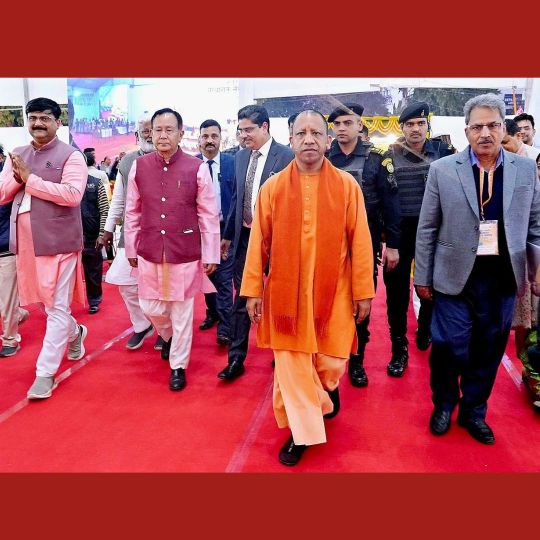

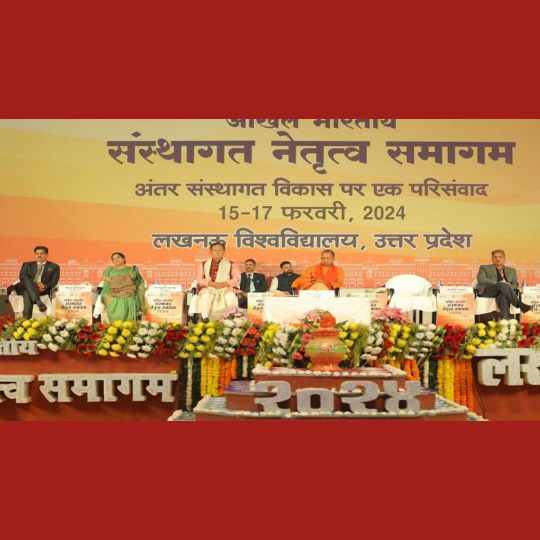
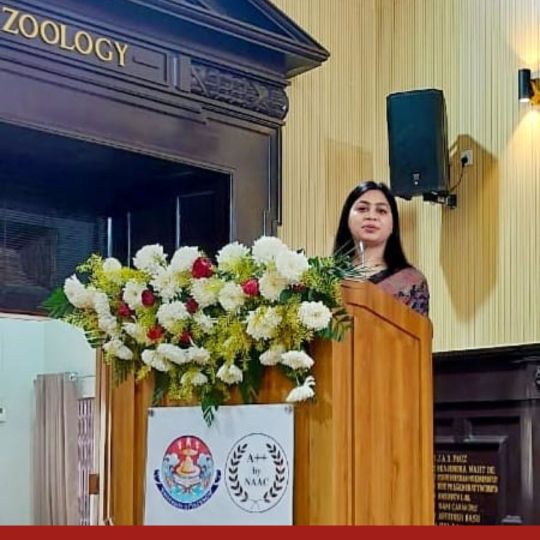
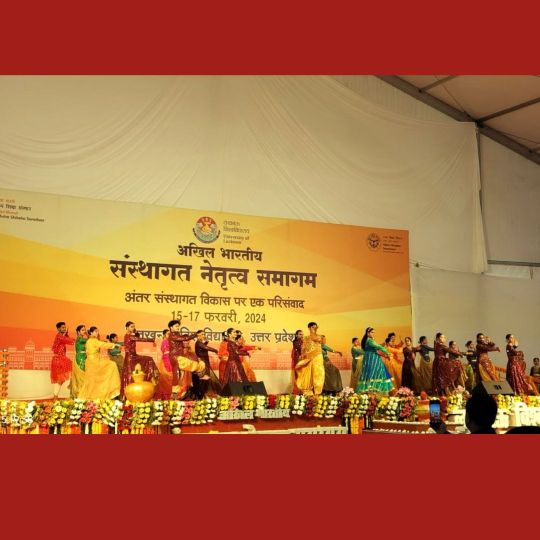


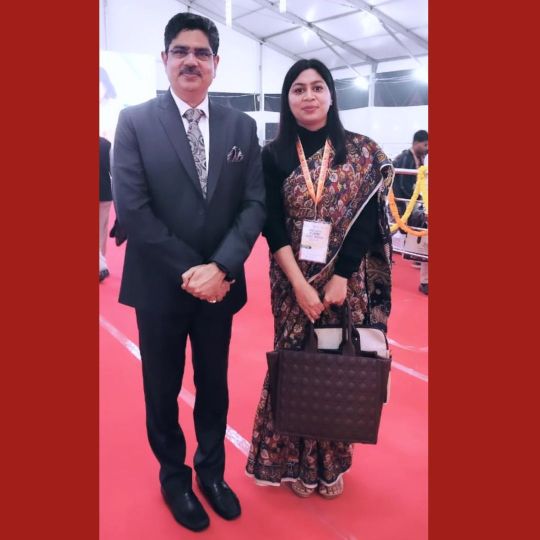
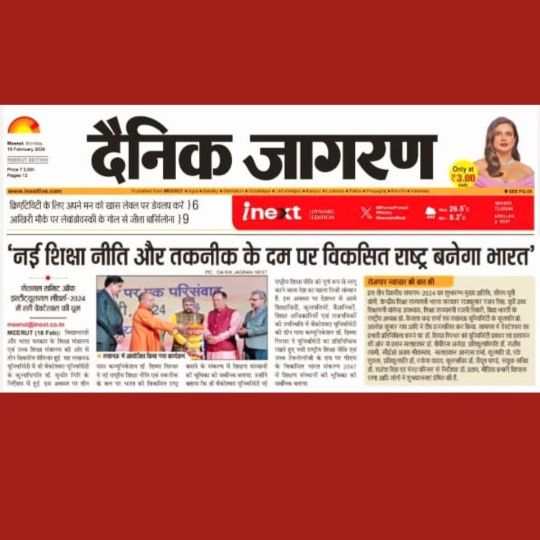

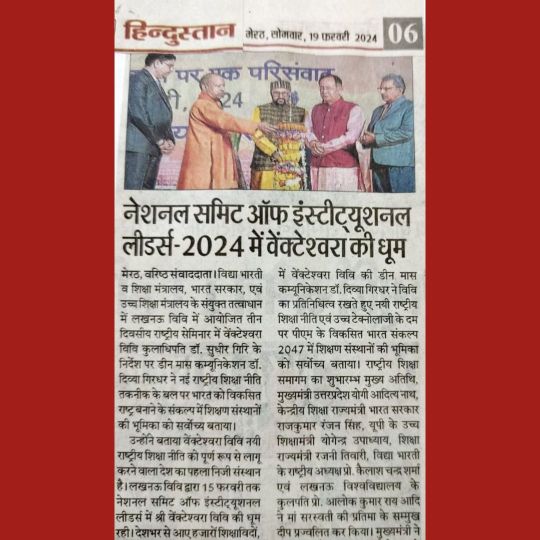
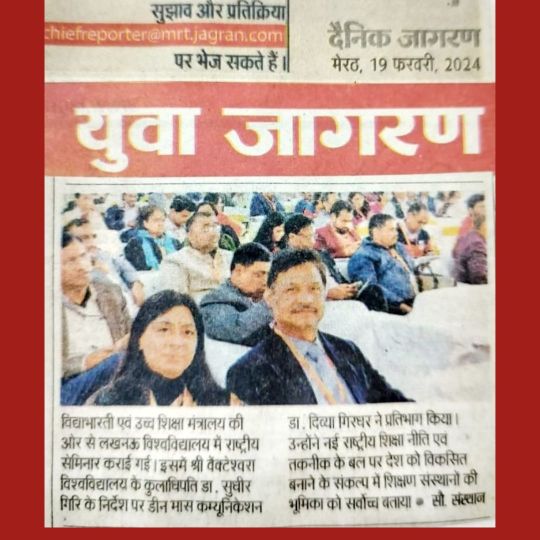
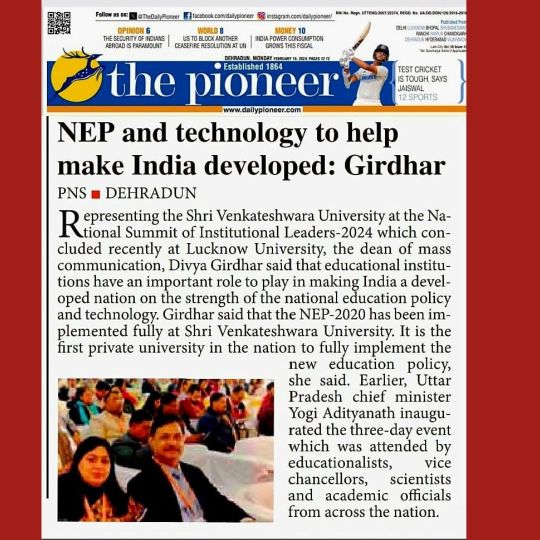
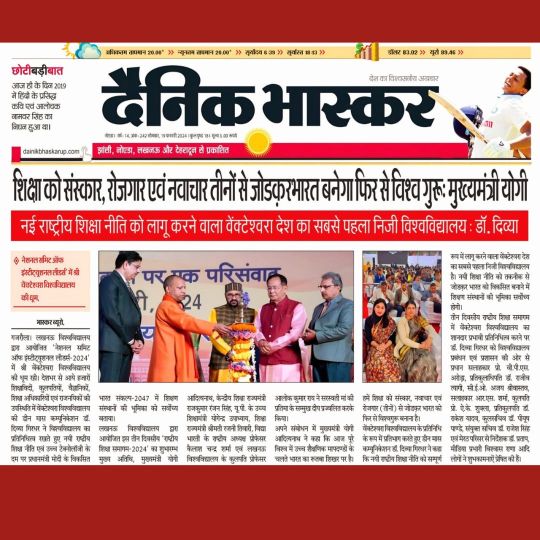

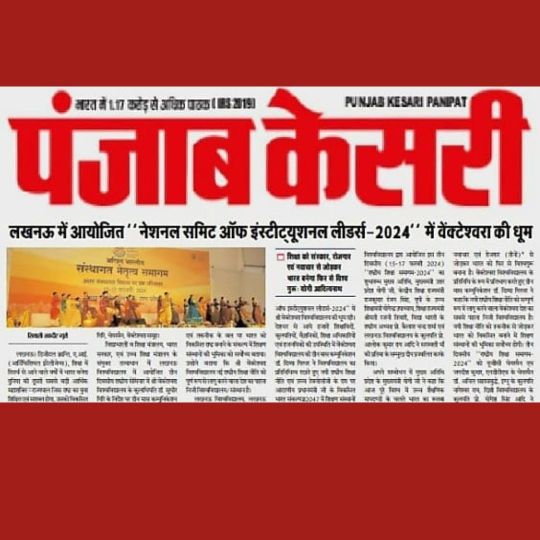
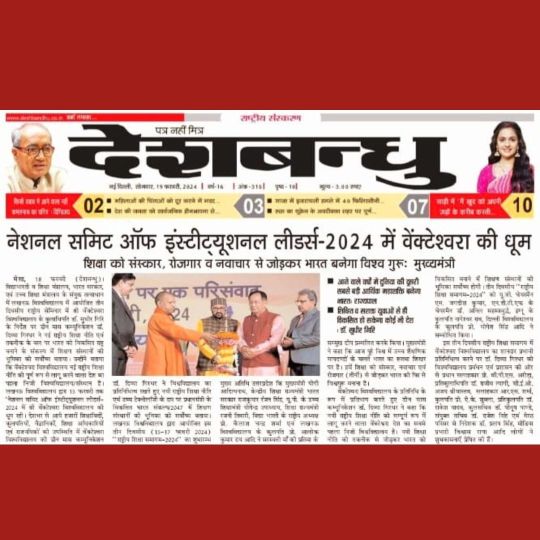
Shri Venkateshwara University was the center of attraction at the 3 day National Summit of Institutional Leaders 2024 held at the University of Lucknow in Lucknow.
Dr Divya Girdhar Dean Mass Communication represented Shri Venkateshwara University at the summit attended by educationists, VCs, scientists, education officers, & Diplomats from all over the world.
Dr Divya Girdhar represented the University at the national seminar, guided by our Chancellor Dr Sudhir Giri, a renowned educationist.
The UP Chief Minister HE Yogi Adityanath Ji, Cabinet MOS for Education Mr Rajkumar Ranjan Singh, & the UP Higher Education Minister Mr. Yogendra Upadhyaya, inaugurated the event by lighting a lamp to Goddess Saraswati.
MOS for Education Mrs. Rajni Tiwari, President of Vidya Bharti Prof. Kailash Chandra Sharma & the VC of Lucknow University Dr Alok Kumar Rai joined them to inaugurate the National Education Conference-2024’.
In his address the UP CM Yogi Adityanath Ji reiterated India is on top of the world for higher education ranking parameters. We need to integrate education with ethics, innovation and employment for India to become a world leader.
Madam Anandi Ben Patel, the Governor of Uttar Pradesh, stated that India will become the second biggest economic superpower in the future. This will be achieved through a digital revolution, the use of artificial intelligence, and by integrating research into education.
The Group Chairman Dr Sudhir Giri reiterated a nation whose youth are educated & empowered, nothing can stop it from becoming a developed nation.
Dr. Divya Girdhar stated that by implementing NEP 2020 and incorporating technology, educational institutions will have a vital role in achieving the Prime Minister’s vision of a Developed India by 2047.
She announced Shri Venkateshwara University has become the first private university in the country to fully adopt NEP 2020 in its curriculum.
The UGC Chairman Dr M Jadish Kumar, Prof. Anil Sahastrabudhe Chairman NETF, VC IGNOU Dr Nageshwar Rao, & the VC of Delhi University Prof Yogesh Singh also addressed the 3 day National Education Conference-2024’.
Dr Divya Girdhar received accolades from the University Management & officials, for strongly representing Shri Venkateshwara University at the National Summit of Institutional Leaders 2024.
Those congratulating her included the Chief advisor Prof. VPS Arora, Pro Chancellor Dr Rajeev Tyagi, CEO Mr. Ajay Shrivastava, Consultant Mr RS Sharma, VC Prof. AK Shukla, & the Pro VC Dr Rakesh Yadav.
The Registrar Dr Piyush Pandey, Joint Secretary Dr Rajesh Singh, Meerut Campus Director Dr Pratap Singh & Media Incharge Mr. Vishwas Rana among others, extended their greetings.
0 notes
Text
Heartiest Congratulations on successful placement!!

Congratulations to students of batch (2020- 2024) CSE department for being placed in ‘’Bharti Airtel Limited“. We wish you a great success ahead.
All the best for future endeavours !!
#congratulations#success#successfulplacement#placement#campusplacement#btech#cse#cbseboard2023#g20#delhincr#aicte#engineeringcollege#engineeringstudents#topprivateengineeringcollegeingreaternoida#bestengineeringcollegeindelhincr#DronacharyaGroupofInstitutions#multipleplacement#greaternoida#uttarpradesh
1 note
·
View note
Text
Campus placement for batch 2020-2024

Heartiest Congratulations on successful placement!!
Congratulations to students of batch (2020-2024) for being placed in “BHARTI AIRTEL LTD.” we wish you great success ahead.
All the best for future endeavours!!
#congratulations#success#successfulplacement#placement#students#btechstudents#engineeringstudents#btech#engineeringcollege#Gurgaon#Haryana#Cse#topengineeringcollegeingurgaon#BestEngineeringCollegeindelhincr#DronacharyaCollegeofEngineering#multipleplacement#Rudransh Tiwari#Karuna Tyagi#Sagar Yadav#Prateek Tanwar#Rohan Saini#Harsh Baghel
0 notes
Text
Mr. Ravinder Bharti

Mr. Ravinder Bharti is a dynamic and accomplished professional in the realm of digital marketing. With a career spanning several years, he has harnessed his extensive knowledge and expertise to lead Public Media Solution to new heights. His dedication and innovation have been pivotal in securing the company's reputation as a top-tier provider of PR, digital marketing, The Healthcare sector, and advertising solutions. His notable awards and accolades underscore his impact on the industry, and his commitment to excellence is evident in his continuous pursuit of innovation.
Biography:
Name: Mr. Ravinder Bharti
Date of Birth: 29th September 1986
Profession: Digital Marketer, Leadership and Business Coach
Height: 168 cm
Weight: 68 kg
Eye Color: Black
Hair Color: Black
Birthplace: Bareilly, Uttar Pradesh
Zodiac Sign: Libra
Nationality: Indian
Hometown: Pune, Maharashtra
Religion: Hinduism
Cast: Kayastha
Hobbies: Networking and Playing Cricket
Career:
School: Kendra Vidhayala
College: B.Tech - Shri Ram Murti Smarak College Of Engineering & Technology
Masters: MBA - Amity University Delhi
Professional Achievements:
Ravinder Bharti is a prominent figure in the digital marketing industry. As the CEO of Public Media Solution, a company renowned for its expertise in PR Agency, Digital Marketing, Healthcare, and Advertising solutions, he has played a pivotal role in its success. His contributions to the field have been recognized with several prestigious awards, including:
40 under 40
Go Global Award 2019
Best Specialist Search Marketing & PR Agency 2020 - India
A Top Placer For Information Technology In 2021
Indian Excellence Award 2018
Best Growing PR Agency in India 2022
Technology Innovator Awards 2020
Rising Stars in PR & eCommerce Media Award 2020
Indian Achievers Award 2023
Family:
Wife: Ritika Bhatnagar
Mother: Mrs. Reenu Bharti
Brothers: Mr. Bhoopendra Bharti (Elder), Mr. Avinash Bharti (Elder)
Father: Mr. R S Bharti
Sister: Mrs. Lata Bharti (Elder)
Children: None
Net Worth: 9 Crore INR
Social Media Channels:
Facebook: www.facebook.com/imravibharti
Instagram: www.instagram.com/imravibharti
LinkedIn: www.linkedin.com/in/imravibharti
Twitter: https://twitter.com/imravibharti
Email: [email protected]
1 note
·
View note
Text
"From Unknown Writer to Global Sensation: Unveiling the Remarkable Journey of MP, the Internationally Acclaimed Author"
Ujjain (Madhya Pradesh): The Hindi Sahitya Bharti, an organization dedicated to the upliftment of Hindi language and literature, is functioning at an international level in 32 countries and 27 states in India.
In pursuit of its objective, the Hindi Sahitya Bharti Ujjain conducted an online poetry writing competition on Hindi Pakhwada in 2020. A total of 145 participants from 18 states took part…
View On WordPress
0 notes
Text
KNOW THE DARK TRUTH OF CELEBRITY WORLD
Bollywood stars are also human beings like ordinary people. A tide of emotions rises in them as well. These stars, who meet each other warmly at parties, are in fact so surrounded by a feeling of competition, jealousy, and insecurity that the pressure of this keeps pushing them towards depression. To avoid this, they resort to liquor or medications, due to which this depression gets worse, due to which it is difficult to handle both success and failure. Last year, on June 15, 2020, when the news of the suicide of film artist Sushant Singh Rajput was published, the entire nation was stunned. . What happened due to which the star, while moving towards this stardom of the film world, taking his life by hanging.
Why only one Sushant, who lives a luxurious life on screen, shows romance with beautiful heroines, Superman who beats ten-ten in one punch and makes millions crazy with his style, charging crores for each film. There is so much in the real-life and reel life of the Venus of Bollywood which is shocking.
Deepika Padukone, the heroine of films like 'Piku', 'Chhapaak', 'Chennai Express, 'Bajirao Mastani', has also been a victim of clinical depression, which she disclosed at the World Economic Forum in the year 2020. Guru Dutt, a well-known director of the Indian film industry in the seventies, producer of 'Pyaasa', 'CID' and 'Kaagaz Ke Phool' and the best actor, was found dead in his apartment in 1964. The reason being, he had ended his life by consuming a lot of alcohol and sleeping pills.
Synonymous with success, director Manmohan Desai, who gave films like 'Amar Akbar Anthony', 'Coolie' and 'Mard', died in 1994 at his Gir village home. No one could understand why the 19-year-old Divya Bharti, who had made crores of people crazy in the films 'Shola Aur Shabnam' and 'Deewana', jumped off the fifth floor or Silk Smitha, the sex bomb of the South. Why did he embrace death?
Talking about some more names in this, MTV's famous VJ Nafisa Joseph, Jiah Khan, who has worked with Amitabh and Aamir, Indian TV industry's girl bride Pratyusha Banerjee, TV actor Kushal Punjabi, as many names as can be taken. Can't believe that this can also be the face of this glam world. There are many reasons behind these famous names of the Bollywood industry full of glamour, fame, and glitz going into depression or suicide in the final stage of depression. Let us try to take a look at them-
READ MORE:
0 notes
Text
THE 5 MOST ADVERSELY IMPACTING EVENTS IN LAST HALF CENTURY OF BOLLYWOOD! -
1. CBFC heavily relaxes its censor rules in 1977, opening itself up to any & all forms, modes & manners of story-telling.
2. Divya Bharti dies in 1993- A bad poisonous omen for new gen to take over on.
3. DDLJ releases in late 1995 - Though a MASTERPIECE FOR IT'S TIME, the poppy trail it left behind in effect, for lesser talented makers, told all next decade.
4. Single-screen culture ends in 2005- Collapsing ~100 yr heavily developed film appreciation system with it.
5. SSR killed in 2020- Bolly freemasonry culture was always a hush hush affair, that didn't affect public psyche TOO MUCH. But hard all-too-obvious evidences that came to light with this case, nullified all blessings past earnt by the industry, reducing it to just another political tool.

1 note
·
View note
Text
Bharti Jha Wiki, Biography, Age, Height, Weight, Family, Net Worth
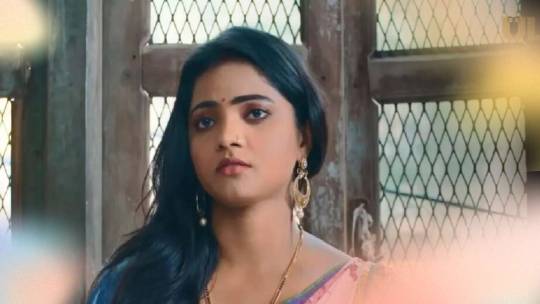
Bharti Jha Wiki: Bharti Jha is a rising Indian actress who debuted in the Bhojpuri film industry with "Haldi Kumkum" in 2020. She subsequently appeared in other Bhojpuri movies, including "Aghori" and "Shaadi by Chance". However, her role in Ullu's Hindi web series "Doraha" brought her into the limelight. Her bold and sizzling scenes in the series won her a massive fan following.
Following the success of "Doraha", Bharti was signed by Ullu Production for two more web series titled "Farebi Yaar" and "Dream Girl", both of which premiered on the Ullu OTT app in February 2023. In addition to these series, she has been a part of several other popular web series across well-known and lesser-known OTT platforms.
Bharti Jha Wiki
Bharti Jha Body Measurements
Bharti Jha Web Series List
Bharti Jha was born on October 28, 1997, in Patna, Bihar, making her 25 years old. She resides in Juhu, Mumbai, and graduated from Patna University after her initial schooling in Bihar. She is proficient in Hindi, Bhojpuri, and English.
While Bharti has not shared details about her family members on any public platforms, she has clarified that she prefers to keep her personal life private. As a result, no information is available about her parents' professions or other details. As of 2023, Bharti is single and unmarried, and no information about her past relationships is available.
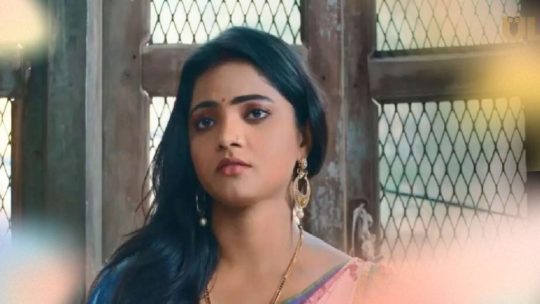
Bharti Jha Wiki
Bharti Jha Wiki
Real NameBharti JhaNick NameBhartiProfessionActressDate of BirthOctober 28 1997Age25 YearsPlace of BirthPatna, BiharNationalityIndianHair ColourBlackEye ColourBlackSexual OrientationStraightZodiac SignScorpioReligionHinduismHometownBiharCurrent LocationJuhu, Mumbai, MaharashtraLanguages KnownHindi, EnglishSchoolUnknown (School from Bihar)CollegePatna UniversityEducational QualificationGraduateTheatreN.AHobbies and Favourites StuffDancing, Acting
Bharti Jha Body Measurements
Height5'5″ ftWeight56 KgsBreast Size34 inchesWaist Size28 inchesHips Size34 inches
Bharti Jha Web Series List
Here is the complete list of her web series streamed on OTT apps.
- Dream Girl (Ullu, 2023)
- Farebi Yaar (Ullu, 2023)
- Doraha 1 and 2 (Ullu, 2023)
- Yes, Mam (Hunters Originals, 2023)
- Babuji (on Primeplay, 2023)
- Paglet 1, 2 and 3 (on Primeplay, 2023)
Read the full article
0 notes
Text
69 Hajar Shikshak Bharti News: 69 हजार शिक्षक भर्ती को लेकर आई बड़ी खबर! अब सुप्रीम कोर्ट तक जा सकता है मामला! शिक्षकों के हक़ में होगा फैसला!
69 Hajar Shikshak Bharti News: बीते दिनों 69 हजार सहायक शिक्षक बहाली के मामले की अलाहबाद हाई कोर्ट में सुनवाई के बाद अभियर्थियों में काफी निराशा देखने को मिल रही है। और यहाँ तक बात चल रही है की अब इसका चैलेंज सुप्रीम कोर्ट में किया जा सकता है।
दरअसल यूपी में जून 2020 से चल रहे 69 हजार सहायक शिक्षकों की बहाली प्रक्रिया में आरक्षण की गड़बड़ी को लेकर कई तथ्य सामने आए हैं।
जानिए मामला एक नज़र में
उन तथ्यों में बिना आरक्षण वालों को आरक्षण कोटा में बहाली और आरक्षित सीट वालों को मेधा सूचि से हटा देने वाले 19000 शिक्षकों के मामले सामने आए हैं। इन मामलों की जांच के लिए अभियर्थियों ने हाई कोर्ट का दरवाज़ा खटखटाया था।
और बीते 13 मार्च को अलाहाबाद हाई कोर्ट ने इसपर सख्ती दिखाते हुए नियोक्ता को अपने काम में पूरी निष्ठा बरतने के सख्त आदेश दिए साथ ही जारी 6800 शिक्षकों के मेरिट लिस्ट को भी ख़ारिज कर दिया।
हालाँकि कोर्ट के इस फैसले के बाद किसी भी राजनैतिक पार्टी से कोई बयान सुनने को नहीं मिला है। लेकिन आए दिन ऐसे मामले सामने आना यह सरकार की नाकामी का और शिथिलता को दर्शाता है।
यह भी पढ़ें>>>
कर्मचारियों-पेंशनरों को बड़ा झटका! संसद में मंत्री का सनसनी खेज बयान! बकाया 18 माह का DA एरियर पर लगी रोक!
Read the full article
0 notes
Text
Virat kholi

Virat Kohli : (born 5 November 1988) is an Indian international cricketer and former captain of the Indian national team who plays as a right-handed batsman for Royal Challengers Bangalore in the IPL and for Delhi in Indian domestic cricket. Widely regarded as one of the greatest batsmen of all time,[3] Kohli holds the record for scoring most runs in both T20 internationals and in IPL. In 2020, the International Cricket Council named him as the male cricketer of the decade. Kohli has also contributed to India's successes, including winning the 2011 World Cup and the 2013 Champions trophy.
Born and raised in New Delhi, Kohli trained in West Delhi Cricket Academy; started his youth career with Delhi Under-15 team. Kohli made his international debut in 2008 and quickly became a key player in the ODI team. He made his Test debut in 2011. In 2013, Kohli reached the number one spot in the ICC rankings for ODI batsmen for the first time. During 2014 T20 World Cup, he set a record for the most runs scored in the tournament. In 2018, he achieved yet another milestone, becoming the world's top-ranked Test batsman, making him the only Indian cricketer to hold the number one spot in all three formats of the game. His form continued in 2019, where he became the first player to score 20,000 international runs in single decade. In 2021, Kohli made the decision to step down as the captain of the Indian national team for T20Is, following the T20 World Cup and in early 2022 he stepped down as the captain of the Test team as well.
Kohli has received many accolades for his performances on the cricket field. He was recognized as the ICC ODI Player of the Year in 2012 and has won Sir Garfield Sobers Trophy, given to the ICC Cricketer of the Year, on two occasions, in 2017 and 2018. Kohli also won ICC Test Player of the Year and ICC ODI Player of the Year awards in 2018, becoming the first player to win both awards in the same year. Additionally, Kohli was named the Wisden Leading Cricketer in the World for three consecutive years, from 2016 to 2018. At the national level, Kohli was honoured with the Arjuna Award in 2013, the Padma Shri under the sports category in 2017 and the Rajiv Gandhi Khel Ratna award, India's highest sporting honour, in 2018.
In 2016, he was ranked as one of the world's most famous athletes by ESPN and one of the most valuable athlete brands by Forbes. In 2018, Time magazine included him on its list of the 100 most influential people in the world. In 2020, he was ranked 66th in Forbes list of the top 100 highest-paid athletes in the world for the year 2020 with estimated earnings of over $26 million. Kohli has been deemed one of the most commercially viable cricketers, with estimated earnings of ₹165 crore (US$21 million) in the year 2022.
Early life
Virat Kohli was born on 5 November 1988 in Delhi to a Punjabi Hindu family. His father, Prem Kohli, worked as a criminal lawyer and his mother, Saroj Kohli, served as a housewife. He has an older brother, Vikas, and an older sister, Bhawna. Kohli's formative years were spent in the Uttam Nagar and commenced his early education at Vishal Bharti Public School. According to his family, Kohli exhibited an early affinity for cricket as a mere three-year-old. He would pick up a cricket bat, display natural skill, and request his father to bowl to him.
In 1998, the West Delhi Cricket Academy (WCDA) was created and on 30 May of that year, Prem Kohli, espoused his younger son's fervor for cricket, assisted nine-year-old Kohli's aspirations and arranged for him to meet Rajkumar Sharma, who initially perceived him to be just another enthusiastic and determined young boy. However, two weeks later, Sharma was impressed by Kohli's accuracy and power in throwing. Upon the suggestion of their neighbours, Kohli's father considered enrolling his son in a professional cricket academy, as they believed that his cricketing abilities merited more than just playing in the gully cricket. Despite his abilities, he faced the setback of being unable to secure a place in the under-14 Delhi team, not due to a lack of merit but due to extraneous factors. Prem Kohli received offers to relocate his son to influential clubs, which would have ensured his selection, but he declined the proposals, as he was determined that Kohli should earn his recognition based on his own merit and overcome the system of nepotism and deceit prevalent in the Delhi and District Cricket Association (DDCA). Kohli persisted and eventually found his way into the under-15 Delhi team. He received training at the academy while simultaneously participating in matches at the Sumeet Dogra Academy located at Vasundhara Enclave. As per Sharma's recollection of Kohli's initial days at his academy, he exuded remarkable talent, making it arduous for the coach to curb his enthusiasm. Kohli remained prepared to bat at any position, and often, Sharma had to physically coerce him to leave the training sessions, as he was reluctant to depart. In pursuit of furthering his cricketing career, he transitioned to Saviour Convent School during his ninth-grade education. Kohli's ardent passion for cricket compelled him to travel long distances with his father to ensure that he never missed a match. With time, he diligently honed his skills and diversified his range of shots, commanding respect from the local bowlers.
On the 19th of December 2006, Kohli experienced the loss of his father due to a cerebral attack. During his childhood, his father played a crucial role in supporting his cricket training. Kohli has credited his father as the one who drove him to practice every day. He has expressed his feelings of missing his father's presence at times. Following the demise of Kohli's father, his mother observed a significant change in his personality. Kohli appeared to become more mature overnight, and he began taking every cricket match seriously. He harbored an aversion to exclusion from games and appeared to channel his entire existence into the pursuit of cricket following his father's untimely demise. It was as if Kohli was pursuing not just his own aspirations but also those of his late father. Kohli's family resided in Meera Bagh, Paschim Vihar until the year 2015, after which they relocated to Gurgaon.
0 notes